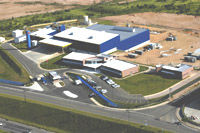Mitsui Chemicals Develops a New High Refractive Index Liquid ("Delphi") for Next-generation Immersion Lithography
Advertisement
Mitsui Chemicals, Inc. (MCI) announced development of a high refractive index liquid ("Delphi") for next-generation immersion lithography in photolithographic processing for semiconductor fabrication. An evaluation by Semiconductor Leading Edge Technologies, Inc. ("Selete") confirmed that Delphi enables a resolution of 32-nm lines and spaces (L/S).
Today, 130-nm semiconductor devices are the mainstream, with 90-nm devices at the cutting edge. However, R&D continues on even finer lines. Generally it is said that finer lines contribute to more powerful semiconductors and smaller electronic devices. For example, 32-nm lithography would make possible 32-gigabit dynamic random access memory4 (DRAM) with 16 times more memory than the mainstream 2-gigabit DRAM manufactured using 130-nm design rules. In developing next-generation immersion lithography technology, most companies in the industry are working on design rules from 65-nm down to 45-nm using water, which provides a refractive index of 1.44.
Delphi, a cyclic hydrocarbon compound, provides a higher refractive index than water of 1.63, thereby facilitating 32-nm semiconductor devices. Under its New Medium-term Business Plan, covering the period between Fiscal 2005 and Fiscal 2008, MCI aims to expand and grow in the field of Performance Materials, comprising functional polymers, information and electronics materials, and healthcare materials. In particular, information and electronics materials focuses on forming and expanding clusters of various new products to augment the lineup of existing core products. MCI therefore aims to make Delphi commercially viable as a new semiconductor material.
Organizations
Other news from the department research and development

Get the chemical industry in your inbox
By submitting this form you agree that LUMITOS AG will send you the newsletter(s) selected above by email. Your data will not be passed on to third parties. Your data will be stored and processed in accordance with our data protection regulations. LUMITOS may contact you by email for the purpose of advertising or market and opinion surveys. You can revoke your consent at any time without giving reasons to LUMITOS AG, Ernst-Augustin-Str. 2, 12489 Berlin, Germany or by e-mail at revoke@lumitos.com with effect for the future. In addition, each email contains a link to unsubscribe from the corresponding newsletter.























































